Snakes are fascinating creatures that come in many different shapes and sizes. Some species are small enough to fit in the palm of your hand, while others can grow to be as big as a human. A few species are capable of growing to truly enormous sizes. In this article, we’re going to look at six species capable of eating a human that are already on the loose and establishing themselves in Florida. So, just avoid Florida, right? Not so fast. The U.S. Geological Survey has predicted that some of these species could thrive in 30% of the United States, maybe even as far north as Washington D.C.!
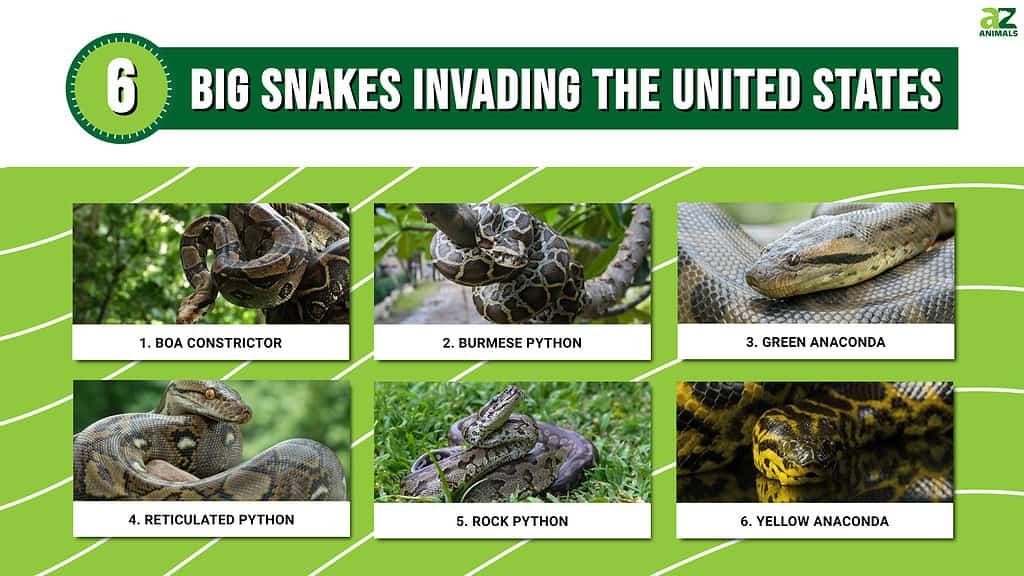
Read on to learn more, including the environmental impact, what is being done to fight back, and how you can be a responsible buddy to a snake if you choose to keep one of these fascinating creatures as a pet.
1. Boa Constrictor

Boa constrictors can grow to be quite large, with some individuals reaching lengths of up to 13 feet and weighing up to 90 pounds.
©Jan Hejda/Shutterstock.com
The boa constrictor is a large, non-venomous snake found in a wide range of habitats throughout Central and South America, as well as some islands in the Caribbean. Boas have been sighted in many counties of Florida, especially in the south and central parts of the state, but in some counties bordering Georgia and Alabama as well.
They are highly adaptable and can thrive in both arid and humid conditions. Boas frequent water sources and are excellent swimmers. They are also good climbers and like trees, rocky outcroppings, and caves. They are nocturnal and spend most of their time hiding in crevices or under rocks during the day.
Boa constrictors can grow to be quite large, with some individuals reaching lengths of up to 13 feet and weighing up to 90 pounds. They have large, irregularly shaped dark brown or reddish-brown blotches on a lighter background. These blotches camouflage them so they can blend in with their surroundings.
2. Burmese Python
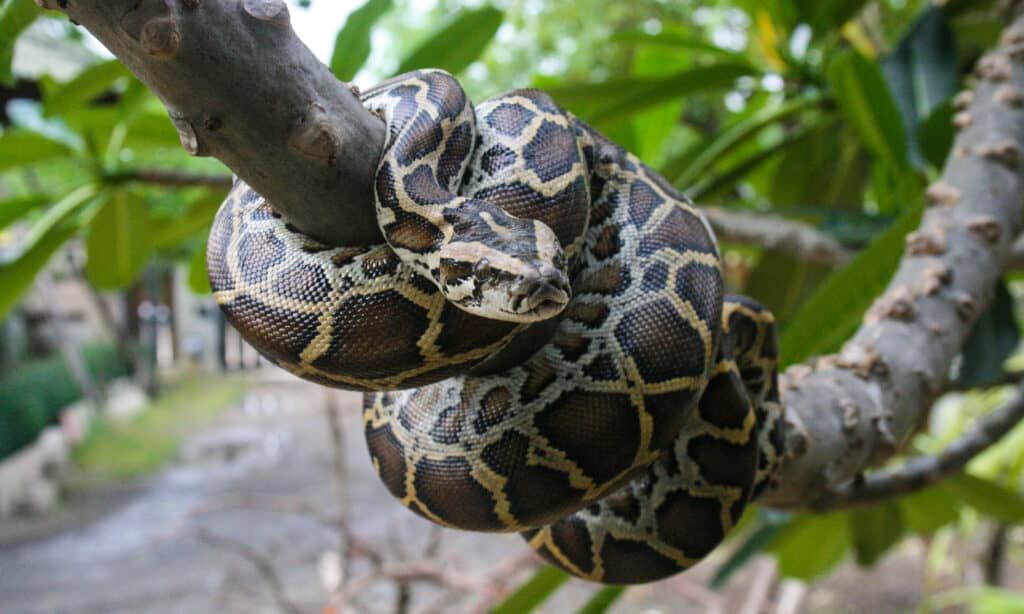
Burmese pythons
, some reaching 26 feet, are already in counties in and around the Everglades.
©iStock.com/Lunatic_67
The Burmese python can reach lengths of up to 26 feet. Its name comes from its native range, which includes parts of Burma (Myanmar). Burmese pythons are already well-established with large breeding populations in Miami-Dade, Monroe, and Collier counties near the Everglades. They have also been sighted as far away as Southern Georgia. They were first discovered on the loose in 1979 and were thought to be unwanted pets released by their owners. In 1992 Hurricane Andrew destroyed an exotic pet breeding facility, releasing a large number of them into the wild. Since then, their numbers have exploded to 100,000 or more. Florida wildlife officials have become alarmed at the rapid decline of prey species in the ecosystem. For some small mammals, populations have dropped as much as 90%.
3. Green Anaconda
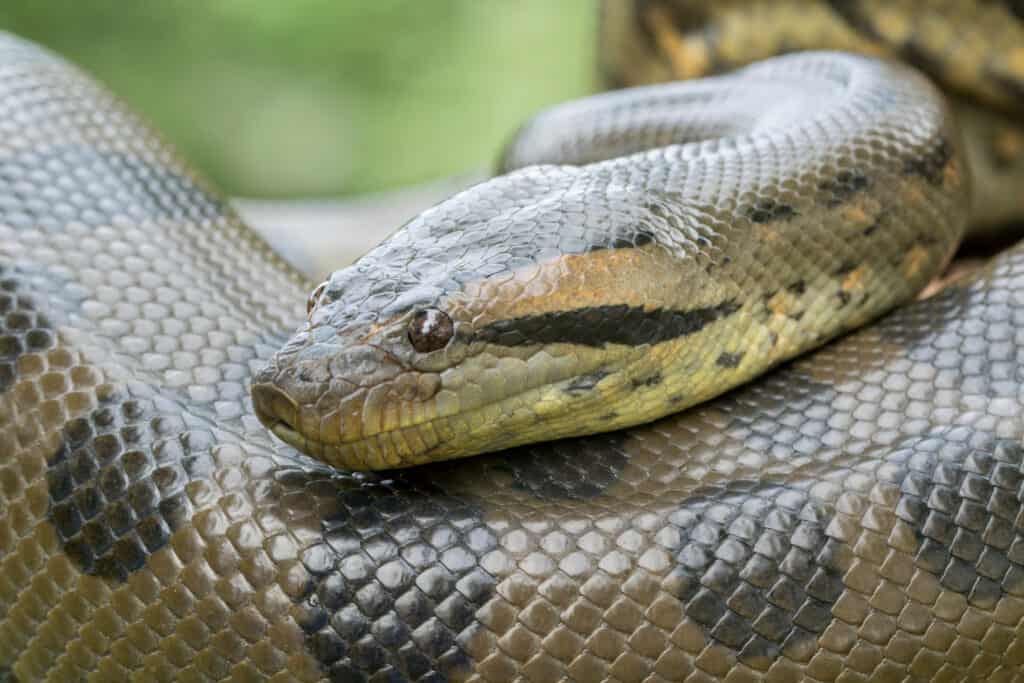
There have been about 11 sightings in Florida of the green anaconda, the largest species of snake in the world.
©Mark_Kostich/Shutterstock.com
The green anaconda is native to South America and is the largest species of snake in the world. An anaconda can reach a whopping 30 feet long and weigh 550 pounds! This potentially enormous size means anacondas are usually not considered good pets but are more often kept in zoos that can provide for their needs.
There have been about 11 sightings of green anacondas in the wild in Florida, as far north as Gainesville and as far south as Miami. Most of the sightings have been around the central parts of the state. Researchers do not think they have become firmly entrenched in the environment yet. Even so, this relatively small number of sightings is alarming, given the size and aggressive nature of this predatory snake.
4. Reticulated Python
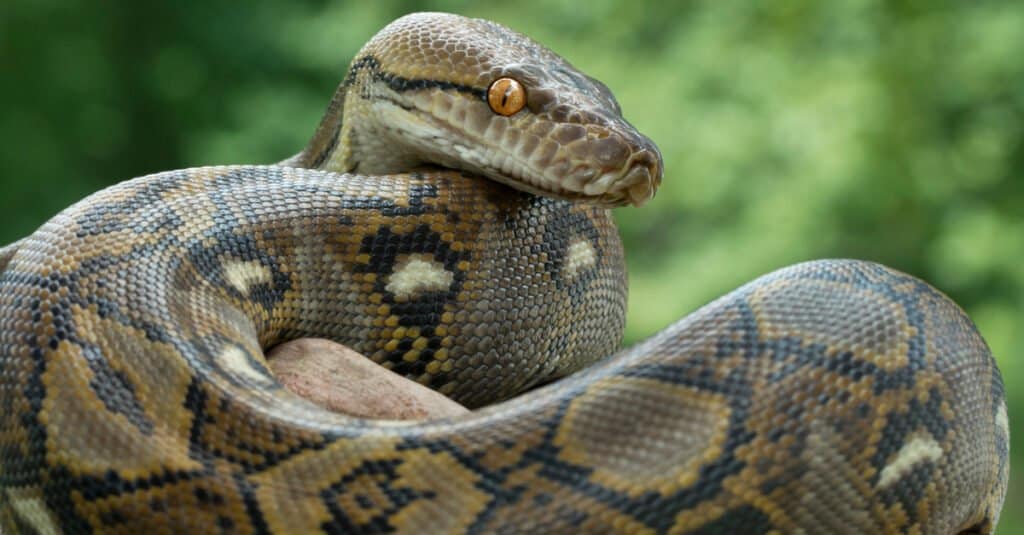
The reticulated python can grow to 30 feet and has been spotted mainly in southern and southwestern counties of Florida.
©Mark_Kostich/Shutterstock.com
The reticulated python can potentially reach lengths of 30 feet. They get their name from the net-like pattern of their scales. Reticulated pythons have been observed in the wild in multiple counties of Florida, but not in the large numbers of some other large invasive snake species. Sightings have been reported in the far southern and southwestern counties of Florida, in the Tampa area, and a few as far north as the Georgia border. Geographically isolated individuals like this are thought to be pets accidentally or intentionally released.
5. Rock Python
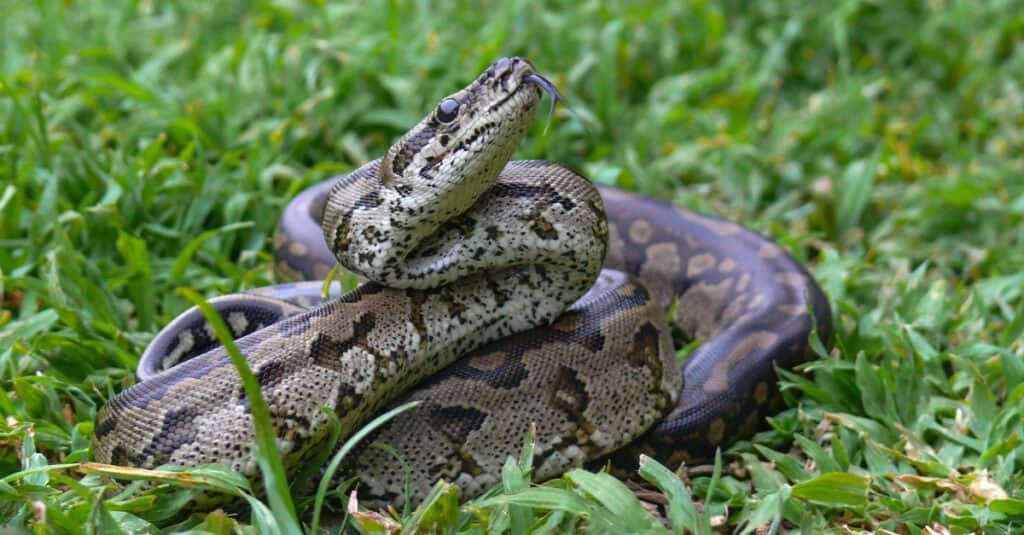
Researchers believe rock pythons, which can reach up to 20 feet, have been established in Florida since the early 2000s.
©Chris Graf/Shutterstock.com
The rock python is native to sub-Saharan Africa. Reaching up to 20 feet, it is the largest snake found in Africa. As the name implies, its preferred habitat is in the crevices of cliffs and rocky outcroppings. Researchers believe rock pythons have been established in Florida since the early 2000s. They have been identified in Miami-Dade and Sarasota counties, but so far only in a small, localized area. Among the snakes found were a pregnant female and two hatchlings. This shows that the species is becoming established as a wild breeding population.
6. Yellow Anaconda
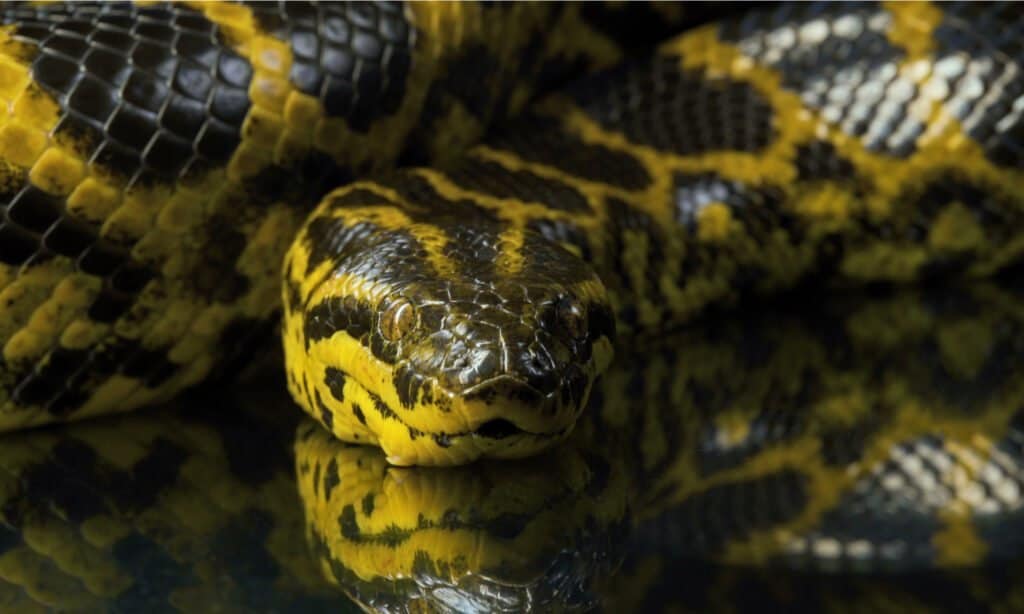
So far, sightings of the yellow anaconda, which can grow to lengths of 20 feet, have been confined to the Florida Everglades in the U.S.
©Chris Tefme/Shutterstock.com
The yellow anaconda, native to South America, grows up to about 20 feet long. This makes it significantly smaller than the green anaconda. Based on size considerations, it can be a more practical pet than a green anaconda. However, it has a reputation as an aggressive species that is not a good choice for beginners. Yellow anacondas have been spotted in the Everglades, but not in such large numbers as other invasive snake species.
Why They Pose a Problem
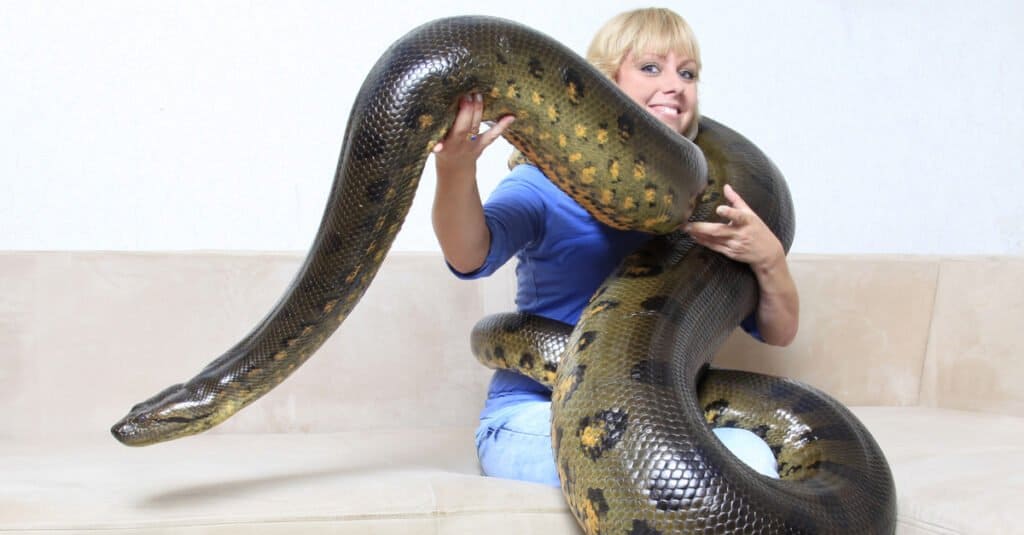
Green anacondas and some other large species can kill humans by constricting them. Some pet owners have met their demise this way.
©Holger Kirk/Shutterstock.com
As you can see from this list, Florida is ground zero for multiplying giant snake species. The vast majority live in the Everglades where relatively few people are active. However, they do sometimes show up in suburban areas, particularly if pet owners release them in populated areas.
Danger to People
While all the snakes on this list are non-venomous and tend to retreat from encounters with adult humans, they will attack if provoked or if particularly aggressive during the breeding season. Their teeth can inflict severe lacerations and introduce disease-bearing bacteria. If they are large and lunge hard enough, they can break a person’s bones. Pets and small children are in real danger of being stalked as prey by these stealthy predators. Even a grown human adult can be killed if the snake is able to get its coils around their neck or torso – a way some unfortunate pet owners have lost their lives.
Environmental Damage
Besides their potential to hurt people, invasive species such as this can have a huge adverse ecological impact. With no natural predators able to hunt them over land, water, or trees, they can multiply virtually unchecked. These kinds of snakes sometimes lay three clutches of eggs a year with 50-100 eggs in each. It is difficult to make precise estimates of how many invasive large snakes now live in the wilds of Florida. Experts suggest the collective total could be anywhere from 100,000 to 1,000,000. Already, populations of raccoons, opossums, and other small mammals are down as much as 90%. Endangered species, such as the Key Largo woodrat, are greatly threatened. Left unchecked and growing to full size, they can also threaten the survival of larger prey, such as deer, wild boar, bobcats, or the Florida panther.
How is Florida Fighting Back?
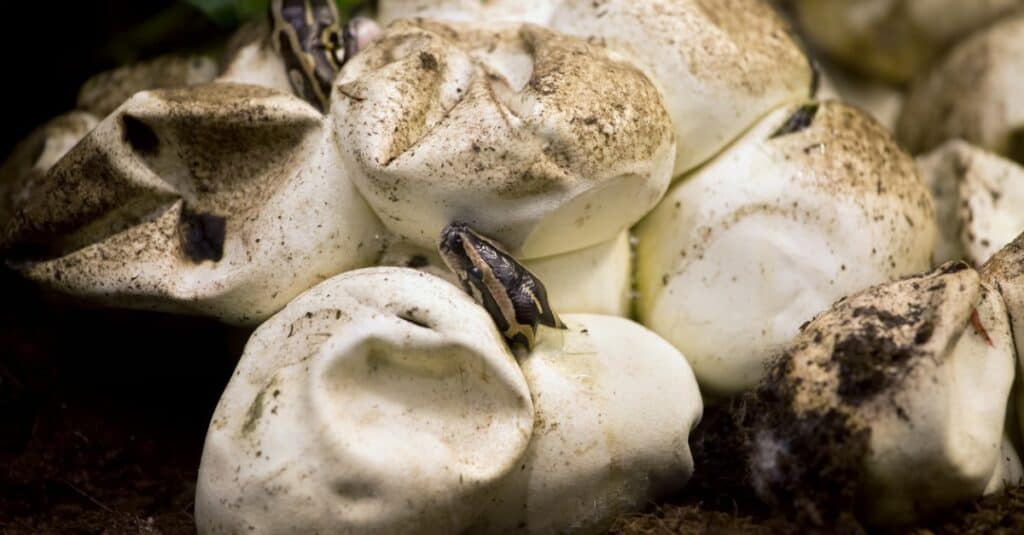
Boas, pythons, and similar species can lay up to 300 eggs a year.
©iStock.com/Artur Bogacki
Wildlife officials have to admit that completely eradicating all these snakes is unrealistic. At this point, the most they hope for is to control their numbers so they don’t completely drive prey species to extinction. Humanely killing pythons in Florida is legal and encouraged. One way officials locate large breeding females is by releasing males equipped with radio trackers during the breeding season. Because the males seek out the largest females, game officials have been able to remove enormous snakes from the environment. One of these, dispatched in 2022, was 18 feet long and weighed 215 pounds. Its last meal had been a full-grown white-tailed deer! Florida also stages an annual contest that gives cash prizes of up to $10,000 to people who catch the largest python or the greatest number of them.
What To Do About an Unwanted Pet Snake
If you are a snake owner who feels you can no longer care for your pet, here are a few options to consider:
- Sell or give away your pet to a new owner, making sure they are aware and prepared for its care requirements.
- Find a snake rescue, humane society, zoo, or pet store willing to take your pet.
- If your state laws permit, humanely euthanize the animal. Your veterinarian may be able to assist.
- Never release a non-indigenous snake into the wild, to avoid danger to humans, pets, and the ecosystem.
What To Do About a Wild Snake
If you encounter a snake on your property or in the wild, take these steps:
- Back away as quickly and safely as possible, removing children and pets from the area.
- If you recognize it as a non-venomous indigenous species, leave it alone to go about its business, as you would a bird or squirrel.
- If you recognize it as a venomous species and it is too close for comfort to your house or other populated areas, call animal control authorities.
- If you recognize it as a non-venomous invasive species, such as a python, do not try to capture it yourself. An individual that was born in the wild or was released by a neglectful or abusive owner may be more aggressive than one that has been frequently handled.
- Some states do permit homeowners to kill some species on their property. Before doing so make sure you are familiar with local species and the laws in your area. It is always safer to call on the services of experts.
Summary of 6 Snakes as Big as Humans that Could Invade the United States
| Snake | Length | |
|---|---|---|
| 1 | Boa Constrictor | 13 feet |
| 2 | Burmese Python | 26 feet |
| 3 | Green Anaconda | 30 feet |
| 4 | Reticulated Python | 30 feet |
| 5 | Rock Python | 20 feet |
| 6 | Yellow Anaconda | 20 feet |
The photo featured at the top of this post is © Heiko Kiera/Shutterstock.com
Discover the "Monster" Snake 5X Bigger than an Anaconda
Every day A-Z Animals sends out some of the most incredible facts in the world from our free newsletter. Want to discover the 10 most beautiful snakes in the world, a "snake island" where you're never more than 3 feet from danger, or a "monster" snake 5X larger than an anaconda? Then sign up right now and you'll start receiving our daily newsletter absolutely free.
Thank you for reading! Have some feedback for us? Contact the AZ Animals editorial team.






